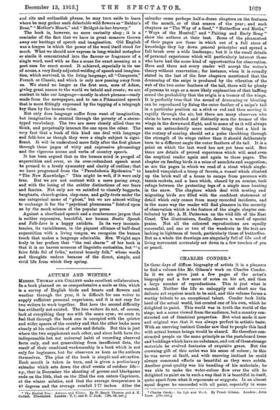AUTUMN AND WINTER.*
Means. THOMAS AND COLLETT make excellent collaborators. In a book planned on so comprehensive a scale as this, which is a survey of English birds and beasts and flowers and weather through. the year, it is difficult for one writer to supply sufficient personal experience, and it is not easy for two writers to work together. But here the second difficulty has evidently not existed. The two writers do not, of course, look at everything they see with the same eyes ; we seem to feel that through the book one is occupied with the quieter and wider spaces of the country and that the other looks more closely at his collection of notes and details. But this is just where the two supplement each other, and since both have the indispensable but not universal habit of recording observed facts only, and not generalizing from insufficient data, the result of their combined workmanship is a book which is not only for beginners, but for observers as keen as the authors themselves. The plan of the book is simple and attmctive. Each month is taken in turn, and is given a preliminary calendar which sets down the chief events of outdoor life — e.g., that in December the shooting of grouse and blackgame ends on the 10th, that on the 22nd the sun enters Capricorn, at the winter solstice, and that the average temperature is 40 degrees and the average rainfall 177 inches. Alter the The English Year: Antnntn and Winter. By W. Beach Thomas and A. K. Collett. Illustrated. London : T. C. and E. C. Jack. flOs. ad. net.] calendar come perhaps half-a-dozen chapters on the features of the month, or of that season of the year ; and such chapters as " The Way of a Seed," " Butterflies and Moths," " Ways of the Hunted," and " Pairing and Early Song " show the authors at their best. Some of the pleasantest of their pages are those in which out of a full store of knowledge they lay down general principles and spread a full brush over a wide landscape; but it is the small details of personal experience which will particularly interest those who have had the same kind of opportunities for observation. Here and there not every reader will accept the writer's theory without reservation ; for instance, when it is roundly stated in the last of the four chapters mentioned that the drumming of the snipe is produced by the vibration of the web of the two outer feathers of the tail, there will be plenty of persons to urge as a more likely explanation of that baffling sound the probability that the origin is a tremor of the wings. It is perfectly true that the sound of drumming or bleating can be reproduced by fixing the outer feather of a snipe's tail in a particular position on a stick or rod and then moving it rapidly through the air, but there are many observers who claim to have watched and distinctly seen the tremor of the wings in the downward flight, and to some of us it will always seem an antecedently more natural thing that a bird in the ecstasy of soaring should set a pulse throbbing through the strength of its wings rather than it should deliberately turn to a different angle the outer feathers of its taiL It is a point on which the last word has not yet been said. But there are details of proved experience which will send even the sceptical reader again and again to these pages. The chapter on feeding birds is a mine of anecdote and suggestion; so are the pages in which we read of a stoat which single- handed vanquished a troop of ferrets, a weasel which climbed up the brick wall of a house to escape from pursuers with tennis rackets, and a hare which, chased by an ermine, took refuge between the protecting legs of a single man hunting in the snow. The chapters which deal with nesting and migrating birds are filled with the confident statement of detail which only comes from many recorded incidents, and in the same way the reader will find pleasure in the security of observation which is the feature of the single chapter con- tributed by Mr. A. H. Patterson on the wild life of the East Coast. The illustrations, finally, deserve a word of special praise. Not all the coloured reproductions are equally successful, and one or two of the woodcuts in the text are lacking in lightness of touch, particularly those of butterflies. But as a whole the drawings are singularly full of life and of living movement accurately set down in a few touches of pen or pencil.


























































 Previous page
Previous page